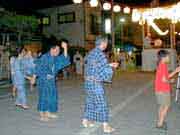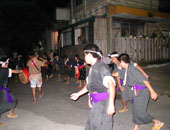“3” Obon
Somehow, there is an image that Obon is in the height of summer.
Today, a way of saying like “The Obon holidays of August” has become established in the news announcements, and there might be many people who believe that Obon is in August through the whole country. However, when I asked a young part time worker in my office about Obon, he answered, “Oh! Obon comes in July in my locality. Relatives gather and are holding Buddhist service for the dead.”
Also, there are cases in which people who come from Okinawa go back to their home town during the end of August to September, saying that “It’s time of Obon.”
How many Obons are there after all?
“3” Obons
If we look out over the present Japan, certainly there are “3” different periods of Obon.
Those are, “Shichigatu Bon (Bon in July)”, “Hachigatsu Bon (Bon in August) (It is also called Tsukiokure Bon (Bon that comes one month later)). Considering the local characteristics, it can be described as the following chart.
| The calendar | Period | Representative region | |
| “Shichigatu Bon (Bon in July)” | The solar calendar | Mainly around July 15th | okyo, Yokohama, Tohoku region, etc. |
| “Hachigatsu Bon (Bon in August)” | The solar calendar | Mainly around August 15th | It is seen in many parts of Japan, etc. |
| “Kyu Bon (Old Bon)” | The lunar calendar | Mainly around July 15th of the lunar calendar (Although it differs depending on the year, in the solar calendar, in many cases it falls on during the latter half of August to September) | Northern part of Kanto region, Chugoku, Shikoku, Kyushu, Southwestern islands, etc. |
(Drawn up according to “Urabon kyo” written by Masao Fujii, published by Kodansha)
Actually, there are cases that the “3” Obons are overlapping in the same region.
Here, the “Hachigatsu Bon” may be called “Kyu Bon” as an idiomatic usage. This is thought to be the usage which considered the comparison with the Shichigatsu Bon, and it is necessary to be careful because it is apt to confuse it with the KyuBon: lunar calendar.
We picked uprepresentative area of the Obon festival, but in reality it is common for two or three Obon to overlap in the same area (shifting the time).
“The switch to the solar calendar from the lunar calendar” changed Obon!”
*Why are there “3” periods of Obon?
The answer is that when the calendar was changed to solar calendar from the lunar calendar in the beginning of the Meiji Era, the localities in Japan reacted differently.
Before the Meiji Era, the Japanese calendar was “lunar calendar” (lunar-solar calendar), and “Tempo Reki (Tempo calendar)” which the Edo Shogunate provided was used. Naturally, the period of Obon was agreed to be in “July of the lunar calendar” nationwide (There were slight gaps depending on the region: cf.”Special Obon”).
In the Meiji Era, the new government decided to adopt the “new calendar” (solar calendar) to standardize the calendar internationally, and switched the calendar by changing December 3rd of Meiji 5 to January 1st of Meiji 6.
*Now, difficulties occurred by the adoption of the new calendar (solar calendar).
The localities faced the problem of what to do with the schedule of festivals and annual events that were held according to the lunar calendar.
Let’s see how the localities responded to the schedule of Obon (July 15th in the lunar calendar)
| The type that considered the new calendar (solar calendar) important (Tokyo, etc.) |
| Changed the calendar to the solar calendar, and used the former schedule of Obon; “July 15th”. As a result, they became to see Obon in a time earlier than before.
Especially, since Tokyo is the “home territory of the emperor”, they strongly felt that they should follow the solar calendar that the government decided. |
| Eclectic type (Kansai and other localities) |
| They changed the calendar to the solar calendar, but in order to adjust to the former schedule of Obon, they put off the date for a month (=Tsuki okure (delay of a month)), and decided the Obon to be on August 15.
Some regions decided the Obon to be on July 15th of the solar calendar for once, but as they thought that “It’s not crispy if we celebrate Obon under the overcast sky in the rainy season”, they staggered it to August. |
| A type that attach importance to the lunar calendar (Southwestern islands and others) |
| They didn’t change the calendar to the solar calendar, and decided to celebrate Obon on “July 15th of the lunar calendar” as they used to.
Okinawa, which is famous for thinking a great deal of their ancestors, could not change the period of celebrating their ancestors. |
The 3 corresponding patterns shown above became the “3” Obon of the present Japan which we have mentioned before.
These switches to solar calendar from the lunar calendar was not carried out at one stroke.
The lunar calendar and the solar calendar were chosen according to the events and regions. Even the time when Obon was established nationwide to some degree to the present Hachigatsu Bon (Obon in August) of the solar calendar was after the WW2.
With the switch of the calendar and dispersion of Obon, gaps began to occur in the period of holding Bon Dancing festivals.
For example, the “Tsukudajima Bon Dancing” which is handed down as the only oldest Bon Dancing in Tokyo is danced in Shichigatu Bon (Obon in July) around July 15th of the solar calendar.
In the other hand, Okinawa, where the tradition of Kyu Bon (Obon held in July 15th of the lunar calendar) remains strongly, they dance “Eisah” (The Bon Dancing of Okinawa) around July 15th of the lunar calendar.
In the other hand, Okinawa, where the tradition of Kyu Bon (Obon held in July 15th of the lunar calendar) remains strongly, they dance “Eisah” (The Bon Dancing of Okinawa) around July 15th of the lunar calendar.
The representative of Shichigatu Bon (Bon in July), Tsukudajima Dancing (Chuo Ward, Tokyo) People celebrate Obon on “July 15th of the lunar calendar” as they used to,Yofuke Eisa(Okinawa Prefecture) Hachigatsu Bon (Bon in August) was established in Awa Dancing (Tokushima City, Tokushima Prefecture)




